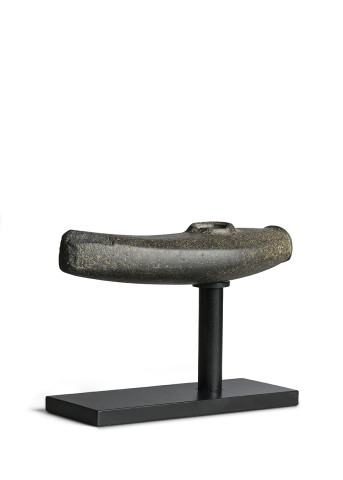Nordic boat axe, Sweden, Ronneby, Neolithic Malmer Period 3/4, c.2500-2400 BC
Black fine-grained stone
Length: 18cm
11121
%3Cdiv%20class%3D%22title_and_year%22%3E%3Cem%3ENordic%20boat%20axe%3C/em%3E%2C%20%3Cspan%20class%3D%22title_and_year_year%22%3ESweden%2C%20Ronneby%2C%20Neolithic%20Malmer%20Period%203/4%2C%20c.2500-2400%20BC%3C/span%3E%3C/div%3E%3Cdiv%20class%3D%22medium%22%3EBlack%20fine-grained%20stone%3C/div%3E%3Cdiv%20class%3D%22dimensions%22%3ELength%3A%2018cm%3C/div%3E
Swedish-Norweigan Battleaxe Culture axe head, carved with a cylindrical collar around the central shaft hole, the body widening towards the hole and narrowing to a pointed tip, the butt on...
Swedish-Norweigan Battleaxe Culture axe head, carved with a cylindrical collar around the central shaft hole, the body widening towards the hole and narrowing to a pointed tip, the butt on a raised plane. The surface polished. A few chips in particular to the one side of the tip and one side of the collar.
Such items were intended for ceremonial or votive purposes. Very little art survives from the European Neolithic age; boat-axes such as this are therefore much admired and sought after works that demonstrate the skill of the Nordic craftsmen.
Provenance
Found prior to 1887 near Ronneby, Sweden
Lars Otto Johan Holst (1863-1936), Ronneby, Sweden
Holst was a veterinary surgeon in Ronneby, southern Sweden from around 1887. Mr Holst took a strong interest in the prehistory of ancient Scandinavia and formed a magnificent collection of early Stone Age artefacts. He obtained these objects locally, partly through his own private excavations, and partly as payment for work done in his service as a vet between 1887-1929.
Literature
Compare Arthur MacGregor ed., Antiquities from Europe and the Near East in the Collection of the Lord McAlpine of West Green (Oxford, 1987), no.4.190





